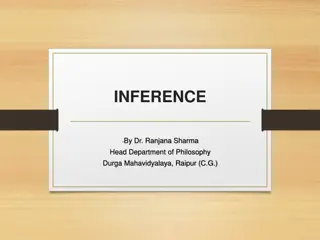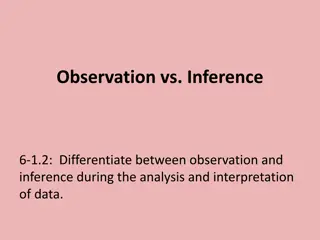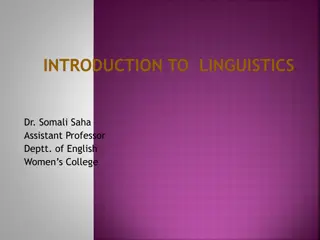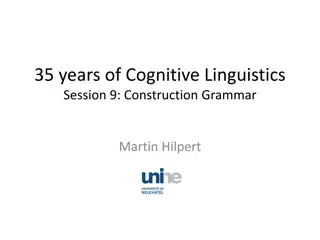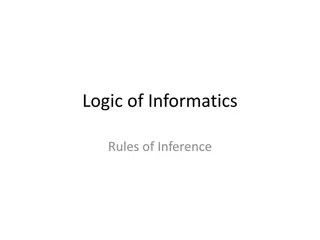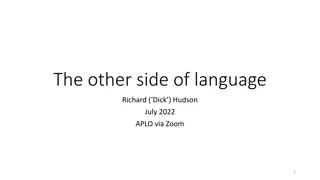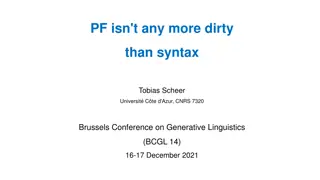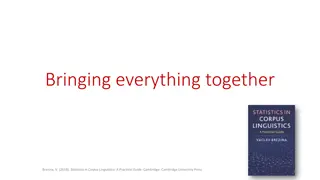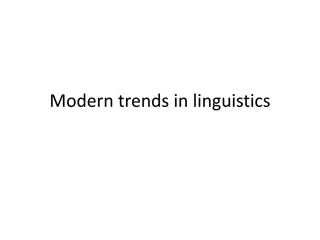Understanding Reference and Inference in Linguistics
Discussing deixis, the act of reference in language is explained as a way for speakers and writers to enable listeners and readers to identify entities. Reference involves using proper nouns, phrases, pronouns, and even invented names. Inference plays a crucial role in successful acts of reference, where the listener's ability to recognize meaning is more important than knowing the dictionary definition of words used. Anaphora involves distinguishing between introducing new referents and referring back to them in discourse.
Uploaded on Sep 19, 2024 | 0 Views
Download Presentation

Please find below an Image/Link to download the presentation.
The content on the website is provided AS IS for your information and personal use only. It may not be sold, licensed, or shared on other websites without obtaining consent from the author. Download presentation by click this link. If you encounter any issues during the download, it is possible that the publisher has removed the file from their server.
E N D
Presentation Transcript
In discussing deixis, we assumed that the use of words to refer to people, places and times was a simple matter. However, words themselves don t refer to anything. People refer. We have to define reference as an act by which a speaker (or writer) uses language to enable a listener (or reader) to identify something. To perform an act of reference, we can use proper nouns (Chomsky, Jennifer, Whiskas), other nouns in phrases (a writer, my friend, the cat) or pronouns (he,
We sometimes assume that these words identify someone or something uniquely, but it is more accurate to say that, for each word or phrase, there is a range of reference . The words Jennifer or friend or she can be used to refer to many entities in the world. As we observed earlier, an expression such as the war doesn t directly identify anything by itself, because its reference depends on who is using it.
We can also refer to things when were not sure what to call them. We can use expressions such as the blue thing and that icky stuff and we can even invent names. For instance, there was a man who always drove his motorcycle fast and loud through my neighborhood and was locally referred to as Mr. Kawasaki. In this case, a brand name for a motorcycle is being used to refer to a person.
INFERENCE As in the Mr.Kawasaki example, a successful act of reference depends more on the listener s ability to recognize what we mean than on the listener s dictionary knowledge of a word we use. For example, in a restaurant, one waiter can ask another, Where s the spinach salad sitting? and receive the reply, He s sitting by the door. If you re studying linguistics, you might ask someone, Can I look at your Chomsky? and get the response
These examples make it clear that we can use names associated with things (salad) to refer to people, and use names of people (Chomsky) to refer to things. The key process here is called inference. An inference is additional information used by the listener to create a connection between what is said and what must be meant. In the last example, the listener has to operate with the inference: if X is the name of the writer of a book, then X can be used to identify a copy of a book by that writer .
ANAPHORA We usually make a distinction between introducing new referents (a puppy) and referring back to them (the puppy, it). We saw a funny home video about a boy washing a puppy in a small bath. The puppy started struggling and shaking and the boy got really wet. When he let go, it jumped out of the bath and ran away. In this type of referential relationship, the second (or subsequent) referring expression is an example of anaphora ( referring back ). The first mention is called the antecedent. So, in our example, a boy, a puppy and a small bath are antecedents and The puppy, the boy, he, it and the bath are anaphoric expressions
Anaphora can be defined as subsequent reference to an already introduced entity. Mostly we use anaphora in texts to maintain reference. The connection between an antecedent and an anaphoric expression is created by use of a pronoun (it), or repetition of the noun with the (the puppy), or the use of other nouns that are related to the antecedent by inference, as in the following examples.
We found a house to rent, but the kitchen was very small. I caught a bus and asked the driver if it went near the downtown area. In the first example, we must make an inference like if X is a house, then X has a kitchen in order to interpret the connection between antecedent a house and anaphoric expression the kitchen. In the second example, we must make an inference like if X is a bus, then X has a driver in order to make the connection between a bus and the driver. In a context where both speakers easily make these types of inferences, it is possible to hear someone complain: I was waiting for the bus, but he just drove by without stopping. When the antecedent is bus, we might expect it as the pronoun, but use of the pronoun he obviously assumes an inference involving the driver
PRESUPPOSITION When we use a referring expression like this, he or Shakespeare, we usually assume that our listeners can recognize which referent is intended. In a more general way, we design our linguistic messages on the basis of large-scale assumptions about what our listeners already know. Some of these assumptions may be mistaken, of course, but mostly they re appropriate. What a speaker (or writer) assumes is true or known by a listener (or reader) can be described as a presupposition.
If someone tells you Your brother is waiting outside, there is an obvious presupposition that you have a brother. If you are asked Why did you arrive late?, there is a presupposition that you did arrive late. And if you are asked the question When did you stop smoking?, there are at least two presuppositions involved. In asking this question, the speaker presupposes that you used to smoke and that you no longer do so. Questions like this, with built-in presuppositions, are very useful devices for interrogators or trial lawyers. If the defendant is asked by the prosecutor, Okay, Mr. Smith, how fast were you going when you ran the red light?, there is a presupposition that Mr. Smith did in fact run the red light. If he simply answers the How fast part of the question, by giving a speed, he is behaving as if the presupposition is correct.



